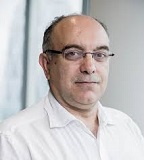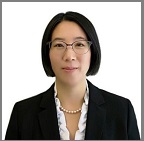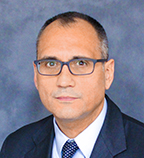2020 Industry Conference Invited Speaker Bios and Abstracts
2020 Industry Conference Agenda
Industry Conference Speakers
- Dr. Danielle Merfeld, VP and CTO, GE Renewable Energy - Advances in Wind Technology … enabling the future of high penetration RE
- Mr. Patrick Panciatici, Scientific Advisor, Réseau de Transport d' Electricité (RTE) - (R)evolution of Power Systems
- Dr. Wendy Zhang, Supervisor of Transmission Planning, PG&E - Use Dual Function Electric Energy Storage as non-wire solution to resolve system reliability issues (thermal overloads)-Oakland Clean Energy Initiative Case Study
- Dr. Val Miftakhov, Founder & CEO, ZeroAvia - Making Aviation Sustainable - 100-seat Zero Emission Jet by 2030
- Dr. Isik Kizilyalli, Associate Director for Technology and Program Director, ARPA-E - Electrifying Innovation: Materials to Systems
Dr. Danielle Merfeld, VP and CTO, GE Renewable Energy
 Danielle Merfeld is the Chief Technology Officer of GE Renewable Energy. In this role, she leads technical efforts to develop differentiated products and services across the broadest renewable energy portfolio in the industry, including onshore wind, offshore wind, solar PV, batteries, and hydro. She also champions sustainability efforts, leading a team focused on achieving carbon neutrality. Additionally, Danielle serves as co-leader of the GE Women’s Network, a global organization focused on the recruiting, retention, development and promotion of talented women across GE.
Danielle Merfeld is the Chief Technology Officer of GE Renewable Energy. In this role, she leads technical efforts to develop differentiated products and services across the broadest renewable energy portfolio in the industry, including onshore wind, offshore wind, solar PV, batteries, and hydro. She also champions sustainability efforts, leading a team focused on achieving carbon neutrality. Additionally, Danielle serves as co-leader of the GE Women’s Network, a global organization focused on the recruiting, retention, development and promotion of talented women across GE.
Danielle received her B.S. degree in Electrical Engineering from the University of Notre Dame, and Ph.D. in Electrical Engineering from Northwestern University. She is a member of several technical associations and on the Board of Trustees at the University of Notre Dame. She serves on the boards of Texas A&M University’s Smart Grid Center and is an Ambassador to the Clean Energy, Education and Empowerment (C3E) Initiative representing the United States.
Title: Advances in Wind Technology … enabling the future of high penetration RE
Abstract: The cost of Wind Energy has been reduced by 50% in the last decade, reaching all-time lows. Key drivers of this trend have included increased manufacturing scale and improved efficiency of the turbine system. As the industry continues to advance, technologies that enable higher penetration of Renewable Energy on the grid will become even more critical to progress. This talk will share a vision for the future of wind energy and explore key technology advances that will drive continued growth.
Mr. Patrick Panciatici, Scientific Advisor, Réseau de Transport d' Electricité (RTE)
 Patrick Panciatici (SM ’11) graduated from Supelec, joined EDF R&D in 1985 then he joined RTE (French Transmission System Operator) in 2003 and participated in the creation of the internal R&D department of RTE. He has more than 30 years’ experience in the field of R&D for transmission systems. Presently, as a senior scientific advisor, he inspires, coordinates and supervises long term research activities in RTE. He is a member of CIGRE, a Fellow of IEEE and an Emerite member of SEE.
Patrick Panciatici (SM ’11) graduated from Supelec, joined EDF R&D in 1985 then he joined RTE (French Transmission System Operator) in 2003 and participated in the creation of the internal R&D department of RTE. He has more than 30 years’ experience in the field of R&D for transmission systems. Presently, as a senior scientific advisor, he inspires, coordinates and supervises long term research activities in RTE. He is a member of CIGRE, a Fellow of IEEE and an Emerite member of SEE.
Title: (R)evolution of Power Systems
Abstract:
Historical Power System: An Emblematic Example of System of Systems.
Electrification is considered by the National Academy of Engineering in USA as the greatest engineering achievements of the 20th Century[1]. This academy acknowledges that large power systems are the most complex machines ever built by mankind. They are since their creation, the most emblematic examples of system of systems: thousands of large generating units interacting with millions of electrical loads through long distance connections (electrical grids).
The electrical grids and their management become more and more complex. This state of affairs has different causes that will not disappear in the near future.
The first reason is the massive integration of renewable but generally intermittent generation and the associated consequences: power electronics, storage, demand side management. The second main reason is that it is more difficult than ever to build new overhead lines because of low public acceptance and “Not In My BackYard” (NIMBY) attitude. The third reason is linked to the setup of electricity markets crossing the administrative borders; they are global optimizers pushing the system towards its limits. The last reason is that the aging of grid assets needs increasing attention. A significant part of the European grids’ assets are more than 50 years old.
The presentation focuses on power system operation and control.
We start by presenting, ideas on a new control architecture, the new role of human operators in the process: navigators rather than pilots and some examples of ongoing projects.
We discuss some topics that present open issues and research challenges.
A topic related to approximation and to reduction of large complex systems, which are indeed mandatory steps in order to design control strategies for power systems. Another important aspect is the control of large population of devices or agents with partial autonomy.
We conclude on some ideas on Machine Learning approaches which are very fashionable but the lack of certificates is certainly a great barrier for their adoptions for controlling critical systems.
Dr. Wendy Zhang, Supervisor of Transmission Planning, PG&E

Wenjuan(Wendy) Zhang is currently the Supervisor at PG&E Transmission System Planning. She manages annual transmission reliability assessment study and develops a portfolio of transmission expansion plans and projects to meet the company's transmission needs for delivery of safe and reliable electric service to our customers while adhering to NERC/WECC/CAISO planning standards. She worked in all three Transmission Planning groups within PG&E, including System Planning, Interconnection Planning, and Regional Planning groups. Prior to PG&E, she worked in CAISO for five years on both Transmission Operation and Planning. In the past 13 years, her career focused on two major areas:
First. she collaborated and conducted the Generation Interconnection (GIP) study on both CAISO and PG&E sides from Cluster 0 to Cluster 5. Second, She has comprehensive experience in large and complex transmission project development, leading cross-functional teams (Protection, Substation, T-Line, Land&Permit), winning favorable positions in stakeholder meetings, and project and process management. Wenjuan received her B.S. degree from the Hebei University of Technology in 1999, her M.S. degree from Huazhong University of Science & Technology in 2003, and her Ph.D. degree from the University of Tennessee in 2007, all in Electrical Engineering. She has published over 30 journal and conference papers in the area of power system planning and optimization.
Title: Use Dual Function Electric Energy Storage as non-wire solution to resolve system reliability issues (thermal overloads)-Oakland Clean Energy Initiative Case Study
Abstract: Historically, Electric Energy Storage (EES) has played three main roles: reducing electricity costs by storing electricity at off-peak time; supporting users during power failures; and maintaining system frequency. This presentation will present an innovative EES application to resolve system thermal overload reliability issues which conventionally are mitigated by transmission solution such as building new transmission lines. In addition to traditional transmission planning methodology, the presentation will demonstrate how to analyze load characteristics in terms of magnitude, duration, timing, and frequency of need in order to decide the MW and MWh size of the EES.
Regarding the case study, CAISO identified the eventual retirement of the Oakland Power Plant as a reliability risk in 2015, 2016, and 2017 Transmission Planning cycles. In concert with key clean energy goals of the community and State of California, PG&E proposed the Oakland Clean Energy Initiative (OCEI) solution to mitigate the underlying electric reliability risk through an innovative combination of utility infrastructure solutions, energy storage, and distributed energy resources (DERs) in collaboration with the customers and the community. CAISO officially approved OCEI in 2018, and it marked the first time that local clean energy resources were proactively deployed as an alternative to fossil-fuel generation to provide transmission reliability.
Dr. Val Miftakhov, Founder & CEO, ZeroAvia
 Val Miftakhov is a Founder & CEO of ZeroAvia, Inc, a California company developing the World's first practical zero emission aviation powertrain. Val is a serial entrepreneur in EV space - his previous company eMotorWerks has developed the World’s leading platform for EV battery aggregation to provide grid services, and was acquired in 2017. Prior to that, Val held a number of senior business and product positions at Google and McKinsey & Company, and was a nuclear researcher at Stanford Linear Accelerator. Val holds a Ph.D. in Physics from Princeton University, Masters in Physics from Moscow Institute of Physics and Technology, and was a two-time winner of Russian Nationwide Physics competitions. In his spare time, Val makes good use of his airplane and helicopter pilot licenses.
Val Miftakhov is a Founder & CEO of ZeroAvia, Inc, a California company developing the World's first practical zero emission aviation powertrain. Val is a serial entrepreneur in EV space - his previous company eMotorWerks has developed the World’s leading platform for EV battery aggregation to provide grid services, and was acquired in 2017. Prior to that, Val held a number of senior business and product positions at Google and McKinsey & Company, and was a nuclear researcher at Stanford Linear Accelerator. Val holds a Ph.D. in Physics from Princeton University, Masters in Physics from Moscow Institute of Physics and Technology, and was a two-time winner of Russian Nationwide Physics competitions. In his spare time, Val makes good use of his airplane and helicopter pilot licenses.
Title: Making Aviation Sustainable - 100-seat Zero Emission Jet by 2030
Abstract: In this session, Val Miftakhov will address the scope of carbon emissions generated by the aviation sector and the challenges the industry faces in reducing emission with existing solutions and discuss the benefits of electrification for aviation. The company’s breakthrough hydrogen-fueled electric powertrain technology will enable 100 seat aircraft by 2030 beginning with a 19-seat zero-emission aircraft operating commercially by 2023, dramatically faster than industry experts anticipated. Miftakhov will also outline what further engineering efforts are required for hydrogen-electric planes to power larger commercial aircraft.
Dr. Isik Kizilyalli, Associate Director for Technology and Program Director, ARPA-E
 Dr. Isik C. Kizilyalli currently serves as the Associate Director for Technology and Program Director at the Advanced Research Projects Agency – Energy (ARPA-E). In this role, Dr. Kizilyalli supports the Deputy Director for Technology in oversight of all technology issues relating to ARPA-E’s programs as well as assisting with program development, Program Director and Fellow recruitment, and coordinating project management across the Agency.
Dr. Isik C. Kizilyalli currently serves as the Associate Director for Technology and Program Director at the Advanced Research Projects Agency – Energy (ARPA-E). In this role, Dr. Kizilyalli supports the Deputy Director for Technology in oversight of all technology issues relating to ARPA-E’s programs as well as assisting with program development, Program Director and Fellow recruitment, and coordinating project management across the Agency.
Kizilyalli’s focus at ARPA-E includes power electronics, wide bandgap semiconductors, electronic systems for hostile environments, electrification of transport (aviation, ships, automotive), subsurface instrumentation, novel drilling concepts, medium voltage DC distribution grids, and grid resiliency against EMP and space weather threats.
Prior to joining ARPA-E, Kizilyalli served as founder, Chief Executive Officer, and Chief Technical Officer of Avogy Inc., a venture backed start-up focused on bulk GaN based vertical power semiconductor technologies and power electronics. Previously, he was with Bell Laboratories, followed by Nitronex Corporation, and solar PV startup Alta Devices where his team holds the world record for single junction solar cell conversion efficiency.
Kizilyalli was elected a Fellow of the Institute of Electrical and Electronics Engineers (IEEE) in 2007 for his contributions to Integrated Circuit Technology. He also received the Bell Laboratories’ Distinguished Member of Technical Staff award and the Best Paper Award at the International Symposium on Power Semiconductors and Integrated Circuits in 2013.
Kizilyalli holds his B.S. in Electrical Engineering, M.S. in Metallurgy, and Ph.D. in Electrical Engineering from the University of Illinois Urbana-Champaign. He has published more than 100 papers and holds 120 issued U.S. patents.
Title: Electrifying Innovation: Materials to Systems
Abstract: This talk discusses three ARPA-E Programs: CIRCUITS, BREAKERS, and CABLES. The CIRCUITS Program builds on earlier ARPA-E programs by designing circuit topologies optimally suited for WBG attributes to maximize overall electrical system performance. Innovations stemming from CIRCUITS projects have the potential to affect high-impact applications wherever electrical power is generated or used, including the electric grid, industrial motor controllers, automotive electrification, heating, ventilation, air conditioning, solar and wind power systems, datacenters, aerospace control surfaces, wireless power transfer, and consumer electronics. The BREAKERS Program is developing novel technologies for medium voltage direct current (MVDC) circuit breakers, applicable to markets including electrified transportation, MVDC grid distribution, renewable interconnections, and offshore oil, gas, and wind production. The CABLES Program addresses power distribution on a twin-aisle notional carrier tackling the technology problems of cables, connectors, and circuit breakers at 10kV and at 10km.

